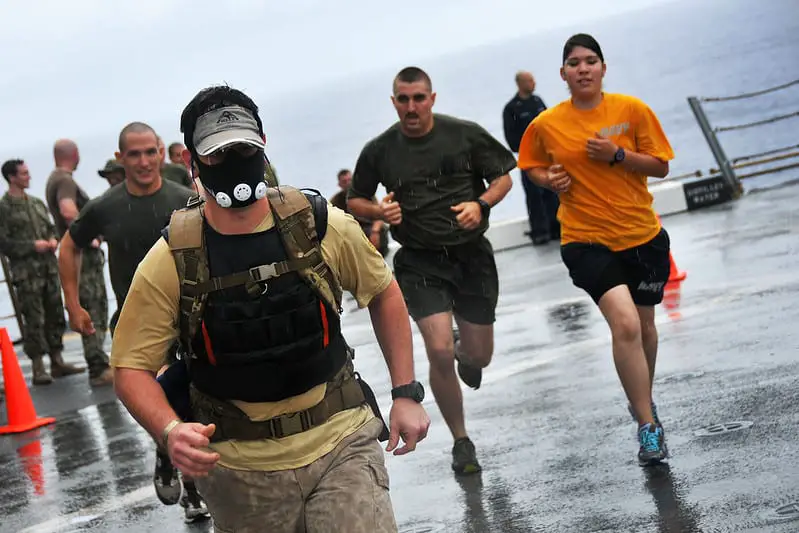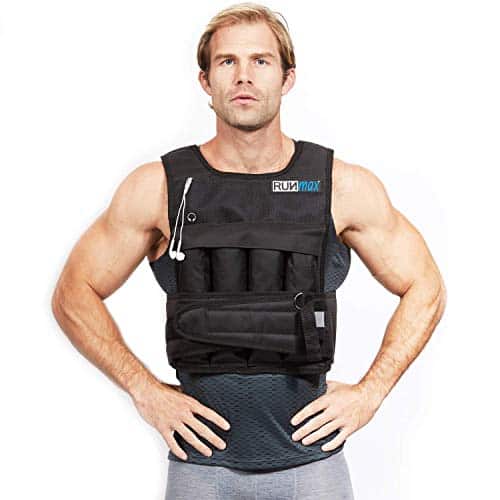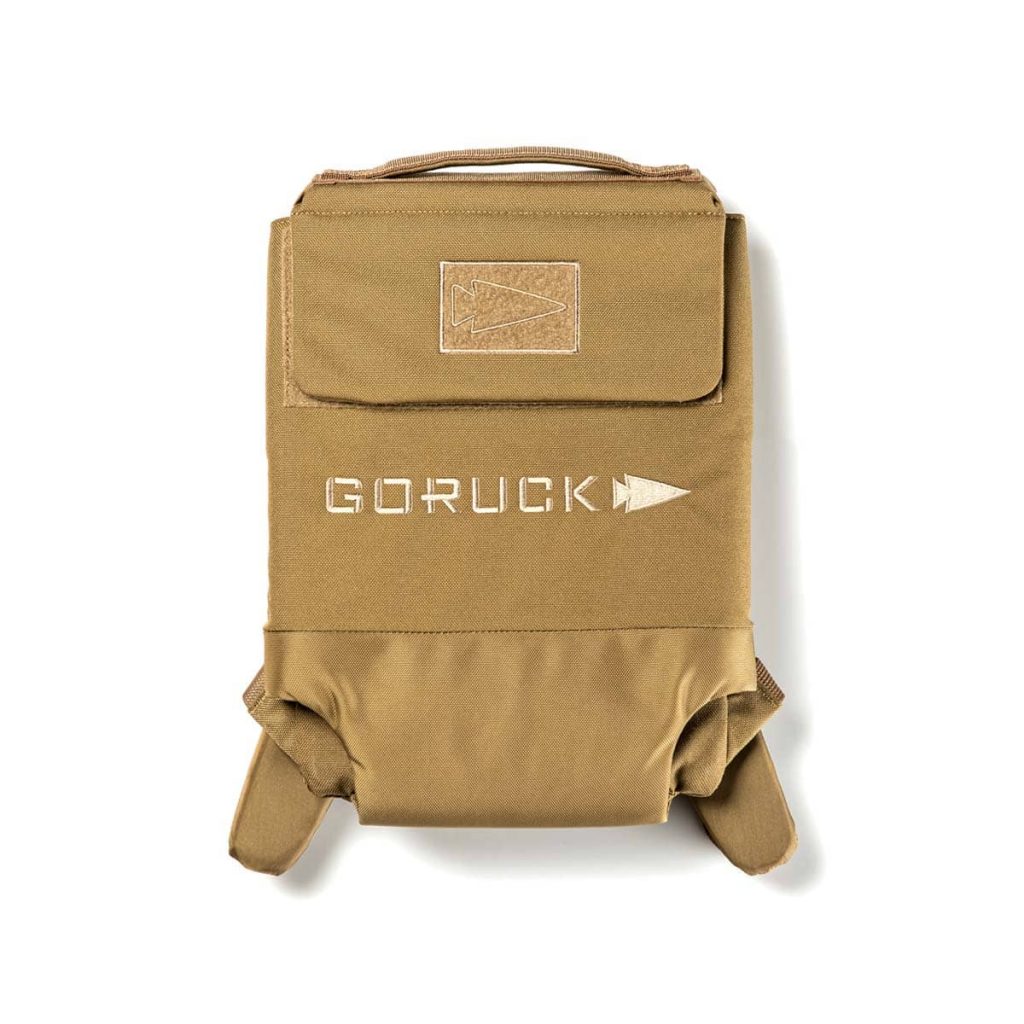
When rucking, the weighted vest is centred around your torso. Allowing you to move freely. Weighted vests keeps you centered, engages your core, and prevents you from leaning forward when the weight is heavy during the ruck which leads to back pain. Weighted vests allows you to change directions easily and allows for more agility.
Weighted vests can be a great alternative than rucksacks for rucking. When considering whether to buy one for rucking or not, here are the main things to consider.
- Weight Capacity
- Comfort and Form
- Multi-use
- Previous Injuries & Form
- How to ruck with a weighted vest
But before we dive into our recommended weighted vests for rucking, here are some benefits of weighted vests compared to rucksacks or backpacks for rucking.
Benefits of Weighted Vests for Rucking
| Weight Distribution | The weighted vest is centred around your torso. Allowing you to move freely. |
| Prevents Potential Back Pain | Weighted vests keeps you centered, engages your core, and prevents you from leaning forward when the weight is heavy which leads to back pain. |
| Flexibility | Weighted vests allows you to change directions easily and allows for more agility. |
| Multi-use | Weighted vests are not just for rucking. You can use them for home workouts, runs, and training for a ruck. |
| Plateau | Your strength and fitness can stop seeing positive results if you’re doing the same workouts. Weighted vests can help you break through that plateau and allow you to see new positive results (strength increase or improved fitness) |
| Improves Cardiovascular System | Similar to rucking, weighted vests provide added resistance to everyday movements and exercises which challenges your muscles and overall fitness giving you more room to improve. |
Speaking of benefits, here’s a complete list of benefits of rucking if you’re still looking for a reason to start!
Weighted Vest Options For Rucking
1- Ruck Plate Carrier 3.0
Comfort is priority with the Ruck Plate Carrier 2.0. They do this by having the lumbar padding support the natural curvature of your back, along with the shoulder straps padding (allowing you to carry more weight comfortably) and a padded top lid to maintain protection during fast movements exercises.
The material is made from 1,000D Cordura, which is the same materials used for making tough and durable rucking rucksacks. A great feature for durability. On top of that, it does include a Scars Lifetime Guarantee so even if you somehow manage to scratch it or break it somehow, they can fix it!
| Pros | Cons |
|---|---|
| Lumbar support | Will take some time to get used to |
| Padded shoulder straps | |
| Includes adjustable training Sternum Strap. | |
| Comfortable & Durable | |
| Includes Scars Lifetime Guarentee | |
| Low instalment payments available |
Check out the Ruck Plate Carrier 3.0 on GORUCK (link to goruck.com)
2- RunFast Weighted Vest

We did come across the RUNFast Adjustable Weighted Vest that can carry up to 140 lbs of weight. If you’re interested, here’s a cheap weighted vest you can check out, RUNFast (Link to Amazon).
The RUNFast weighted vest has customizable weights of up to 20 lbs, 40 lbs, and 60 lbs options. Furthermore for comfort, it comes with two padding options: shoulder padding or no shoulder padding.
Check out the RUNFast weighted vest if you’re interested (link to Amazon)
3- Car Barbell Adjustable Weighted Vest

We came across the CAP Adjustable Weighted Vest that we highly recommend for rucking. It’s flexible and we’re able to get it at 80lbs. It ranges from 40lbs – 150 lbs.
You don’t need to worry about the sizing as it has a one-size fits all along with an adjustable belt to ensure that the weighted vest is tightly secured. The included weights are adjustable and can be removed at any time.
Rucking weighted vests aside, lets dive into the benefits of rucking with a weighted vest.
Check out the Car Barbell Weighted Vest on Amazon (link to amazon).
Comfort & Form
If you’re a frequent rucker or not, you may have experience some real pain during and after your ruck. The constant weight on your back and shoulders can cause serious discomfort (if you slack on your form, which a lot of us do). Learn more about shoulder pain from rucking and how to avoid it.
This is where weighted vests come into play. They are pretty much hugging you, ensuring that the weight is balanced on your torso. It prevents the typical lower back pain that comes with carrying a heavy rucksack that forces you to lean forward.

If comfort is a big thing for you, then consider getting a weighted vest that has the appropriate weight per your body weight and that has shoulder pads. Not too long ago, we came across the MIR weighted vest (link to Amazon). It comes with a standard or zipper option and can carry up to 45 lbs.
Remember, when getting your weighted vest, make sure that it’s comfortable and can carry the appropriate amount of weight. We typically recommend for beginners to carry around 15% of your body weight. Check out our rucking for beginners guide for more juicy details.
Weight Capacity
People ruck for different reasons. Some, like us, do it for the social and health benefits. While others do it for military use. Whatever your intention is though, if your goal is to carry more weight for a ruck event, you have to carry weight that is truly challenging for you.

If you’re training for a military ruck march, this weighted vest will help you endure more weight, but you should still supplement your training with a weighted rucksack. Check out our favourite rucksacks here.
Multi-Use
While some say you shouldn’t get a weighted vest because you can’t use it in some rucking events, that’s certainly does not mean it’s useless. You can use a weighted vest interchangeably when you train for a ruck event to avoid injury while training for a ruck.
Part of training for rucking includes working out. Improving your stamina and strength prior to a rucking event is very important. It helps improve your endurance, which helps you to last longer in the event, and generally improves your health. Moreover, rucking burns a lot of calories!
With a weighted vest, there are TONS of workouts and exercises you can do to improve your cardio, strength, and readiness for a ruck. Check out our best exercises for Rucking post to learn more.
Plateau
There’s nothing more frustrating than dealing with a plateau. You’ve been doing all the rucking exercises, sticking to your rucking schedule and diet but still not seeing new improvements in your ability to carry more weight or lose more weight.
Unfortunately, we all go through a similar phase. This is because our body got accustomed to the same workouts, same resistance, and activating the same muscles.
This is where weighted vests come into play. They force you to activate and use muscles that you might not have activated or worked out. A weighted vest will change the routine and make it difficult for your muscles to adapt to the changed form of resistance.
The more you can shock your muscles and push your fitness levels, the more improvement you will see in your rucking sessions.
Improves Cardiovascular System
This is an obvious one, but similar to rucking, a weighted vests adds more resistance to your body. This makes everyday movements more difficult and forces your muscles to adapt to the new weight. Furthermore, the added resistance will deplete your oxygen levels which will increase your aerobic endurance.
You will notice that your heart rate is increasing and you’ll break a sweat before you know it.
The Risks of Rucking with a Weighted Vest
Generally speaking, weighted vests can further exacerbate the pain from previous injuries or other injuries caused by rucking with improper form.
If you had previously been feeling any pain (i.e lower back pain) from the weight due to past rucking injuries, we would highly recommend that you work on solving that issue first prior to trying to replace the weighted vest for a rucksack.
If you’re using a weighted vest for activities beyond rucking like pull-ups or push-ups, a common mistake people make is “cheating the rep”. This means that some people tend to rely on other body parts to complete the exercise.
For example, if John is attempting to do a pull up with a weighted vest, he may feel the need to swing aggressively to pull himself up, this can lead to to added stress to joints and other points.
Simply put, if you’re unable to perform any exercise (including rucking) without the weighted vest, you may want to reconsider using a weighted vest. Prefect the fundamentals first before using a weighted vest.
This concept most certainly applies when rucking. Check out our rucking tips to learn more about rucking with proper form.
How To Ruck with a weighted Vest
If you’re using a weighted vest for rucking for the first time, wear it and load 5% of your body weight. This will avoid shocking your body to the change of resistance.
After a few sessions, you will be able to determine and assess which body parts are most sore (you’ll be surprised what muscles will be activated that normally aren’t).
After that, work your way up to 10% of your body weight. When that starts to feel tolerable or too easy, feel free to keep on increasing the weight.
Weighted Vest or Rucksack: What’s Right For You?
This depends on why you are rucking.
If you’re rucking to join the military and meet the army ruck march standards, we highly recommend that you use a rucksack. This is because the military standard to ruck 12 miles in 3 hours carrying weight anywhere from 68 to 100 pounds is very intense.
Not only is it intense, but it will require a lot of practice prior to joining he military to prepare for the military. We hate to say it but a weighted vest will not help you with that.
This is because its more than just the amount of weight you’re carrying. Rucking with a weighted vest does not set you up or help you train for realistic military rucking requirements.
Also, you will want to get used to rucking with a rucksack to get used to it and prevent common rucking injuries.
Other than the military, if you find yourself needing access to a lot of things during your rucks like hydration, snacks, etc then you wont have space for it in the weight vest.
If you’re rucking solely as a means of getting in shape, you should absolutely use a weighted vest.
CrossFit and other rucking events use weighted vest to intensify their workouts. The weighted vest gives you more flexibility and intensify any HIIT workout that you’re integrating into your work out.
Related Questions
Do Weighted Vest Build Muscle?
Weighted vests can definitely help you build more muscle. This is because they provide extra resistance that your body needs to break down the muscle (and eventually repair it, this is how muscle growth happens in a nutshell).
If you’re incorporating different hypertrophy workouts in your ruck session, you will be able to build muscle (assuming your nutrition and sleep is on point too).
How Heavy Should Your Weighted Vest Be?
A big part of this involves listening to your body and taking into account the workout ahead. If you’re going to a ruck event that involves a High Intensity Interval Training component, then you may want to adjust your weight accordingly.
Here are three easy ways to tell if the weight you’re carrying in your weighted vest is too heavy (during a ruck or in any other workout):
- Cheating your reps
- Poor posture
- Post workout rucking injuries
Learn more about how much weight you should carry when rucking.


